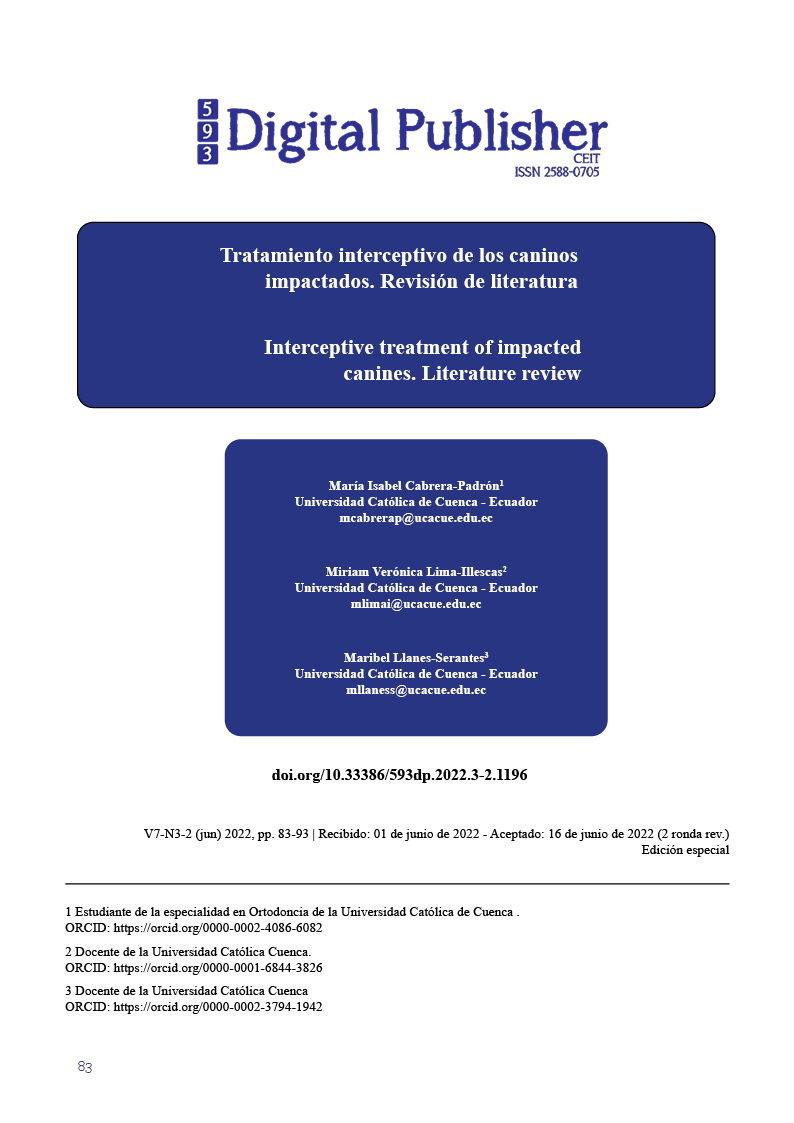Tratamiento interceptivo de los caninos impactados. Revisión de literatura.
Contenido principal del artículo
Resumen
Un diente impactado es aquel que no realiza su proceso de erupción a la arcada dentaria en el tiempo deseado, por lo que es necesario un diagnóstico oportuno y eficaz para poder determinar la terapia adecuada que se debe llevar. El objetivo es analizar las publicaciones existentes sobre los procedimientos terapéuticos interceptivos recomendados para evitar la impactación canina. Se analizaron artículos que fueron obtenidos de cuatro bases de datos digitales: PubMed, Scopus, Web of Science, Bvs, las palabras claves se seleccionaron de “Mesh” usando el operador booleano AND, Orthodontics, Interceptive, Tooth, Impacted, Cuspid, Maxilla. Los criterios de inclusión fueron: Reporte de casos clínicos, estudios de caso-control, ensayos clínicos aleatorizados, revisiones sistemáticas, metaanálisis, artículos publicados en los últimos 5 años, en idioma inglés y español, artículos publicados hasta enero del 2022 y de acceso libre. La literatura evaluó la efectividad del tratamiento interceptivo de caninos impactados y se determinó que existe una alta tasa de erupción en los casos en los que se han realizado extracciones de dientes temporales mejorando los resultados cuando se evita la mesialización del primer molar. Se evidenció que los procedimientos interceptivos realizados en casos de caninos impactados la extracción de los caninos más el uso de arnés de tracción cervical o barra transpalatina acompañado de la expansión rápida del maxilar resultará en un cambio del entorno, dirección y posición del diente impactado dando como resultado una erupción espontánea.
Descargas
Detalles del artículo

Esta obra está bajo una licencia internacional Creative Commons Atribución-NoComercial-CompartirIgual 4.0.
1. Derechos de autor
Las obras que se publican en 593 Digital Publisher CEIT están sujetas a los siguientes términos:
1.1. 593 Digital Publisher CEIT, conserva los derechos patrimoniales (copyright) de las obras publicadas, favorece y permite la reutilización de las mismas bajo la licencia Licencia Creative Commons 4.0 de Reconocimiento-NoComercial-CompartirIgual 4.0, por lo cual se pueden copiar, usar, difundir, transmitir y exponer públicamente, siempre que:
1.1.a. Se cite la autoría y fuente original de su publicación (revista, editorial, URL).
1.1.b. No se usen para fines comerciales u onerosos.
1.1.c. Se mencione la existencia y especificaciones de esta licencia de uso.
Citas
Al-Abdallah, M., AlHadidi, A., Hammad, M., & Dar-Odeh, N. (2018). What factors affect the severity of permanent tooth impaction? BMC Oral Health, 18(1), 1–7. https://doi.org/10.1186/s12903-018-0649-5
Alyammahi, A. S., Kaklamanos, E. G., & Athanasiou, A. E. (2018). Effectiveness of extraction of primary canines for interceptive management of palatally displaced permanent canines: A systematic review and meta-analysis. European Journal of Orthodontics, 40(2), 149–156. https://doi.org/10.1093/ejo/cjx042
Andrade, I., Paschoal, M. A. B., & Santos, T. de O. (2019). Spontaneous eruption of severely impacted teeth: The report of two cases. Journal of Clinical and Experimental Dentistry, 11(5), e491–e495. https://doi.org/10.4317/jced.5491
Arboleda-Ariza, N., Schilling, J., Arriola-Guillén, L. E., Ruíz-Mora, G. A., Rodríguez-Cárdenas, Y. A., & Aliaga-Del Castillo, A. (2018). Maxillary transverse dimensions in subjects with and without impacted canines: A comparative cone-beam computed tomography study. American Journal of Orthodontics and Dentofacial Orthopedics, 154(4), 495–503. https://doi.org/10.1016/j.ajodo.2017.12.017
Barros, S. E., Hoffelder, L., Araújo, F., Janson, G., Chiqueto, K., & Ferreira, E. (2018). Short-term impact of rapid maxillary expansion on ectopically and normally erupting canines. American Journal of Orthodontics and Dentofacial Orthopedics, 154(4), 524–534. https://doi.org/10.1016/j.ajodo.2018.01.011
Benson, P. E., Atwal, A., Bazargani, F., Parkin, N., & Thind, B. (2021). Partn2. Interventions for promoting the eruption of palatally displaced permanent canine teeth, without the need for surgical exposure, in children aged 9 to 14 years. Cochrane Database of Systematic Reviews, 2021(12). https://doi.org/10.1002/14651858.CD012851.pub2
Bjerklin, K. (2020). Orthodontic management of impacted maxillary canines. APOS Trends in Orthodontics, 10(2), 64–71. https://doi.org/10.25259/APOS_41_2020
Björksved, M., Magnuson, A., Bazargani, S. M., Lindsten, R., & Bazargani, F. (2019). Are panoramic radiographs good enough to render correct angle and sector position in palatally displaced canines? American Journal of Orthodontics and Dentofacial Orthopedics, 155(3), 380–387. https://doi.org/10.1016/j.ajodo.2018.05.015
Boonpratham, S., Pariyatdulapak, N., Poonpiriya, T., Peanchitlertkajorn, S., & Saengfai, N. N. (2021). The efficacy of rapid palatal expansion on the eruption of impacted maxillary canine: A systematic review. Australasian Orthodontic Journal, 37(2), 273–283. https://doi.org/10.21307/aoj-2021.030
Camarena-Fonseca, A. R., Rosas Gonzales, E. J., Cruzado-Piminchumo, L. M., & Liñán Durán, C. (2017). Métodos de diagnóstico imagenológico para optimizar el plan de tratamiento y pronóstico de caninos maxilares. Revista Estomatológica Herediana, 26(4), 263. https://doi.org/10.20453/reh.v26i4.3033
Caprioglio, A., Castiglioni, F., Sambataro, S., Giuntini, V., Comaglio, I., Lorvetti, F., & Fastuca, R. (2020). Changes in canine inclination after rapid and slow maxillary expansion compared to untreated controls. Orthodontics and Craniofacial Research, 23(3), 351–356. https://doi.org/10.1111/ocr.12377
Crincoli, V., Tettamanti, L., Lucchina, A. G., Dedola, A., Cazzolla, A. P., Lacaita, M. G., & Mastrangelo, F. (2019). Correlation between maxillary canine impaction and facial biotype. Journal of Craniofacial Surgery, 30(4), 1044–1048. https://doi.org/10.1097/SCS.0000000000005279
De Stefani, A., Bruno, G., Visentin, S., Lucchi, P., & Gracco, A. (2021). Rapid maxillary expansion for interceptive orthodontic treatment of palatally displaced canine: A systematic review. European Journal of Paediatric Dentistry, 22(2), 139–143. https://doi.org/10.23804/ejpd.2021.22.02.10
Elangovan, B., Pottipalli Sathyanarayana, H., & Padmanabhan, S. (2019). Effectiveness of various interceptive treatments on palatally displaced canine–a systematic review. International Orthodontics, 17(4), 634–642. https://doi.org/10.1016/j.ortho.2019.08.002
Gandía-Aguiló, V., Cibrián, R., Soria, E., Serrano, A. J., Aguiló, L., Paredes, V., & Gandía, J. L. (2017). Use of self-organizing maps for analyzing the behavior of canines displaced towards midline under interceptive treatment. Medicina Oral, Patologia Oral y Cirugia Bucal, 22(2), e233–e241. https://doi.org/10.4317/medoral.21509
Ghaffar, F., Sukhia, R. H., & Fida, M. (2019). Association between maxillary transverse discrepancy and occurrence of potentially impacted maxillary canines in mixed dentition patients. International Orthodontics, 17(3), 554–561. https://doi.org/10.1016/j.ortho.2019.06.016
Grisar, K., Luyten, J., Preda, F., Martin, C., Hoppenreijs, T., Politis, C., & Jacobs, R. (2021). Interventions for impacted maxillary canines: A systematic review of the relationship between initial canine position and treatment outcome. Orthodontics and Craniofacial Research, 24(2), 180–193. https://doi.org/10.1111/ocr.12423
Hadler-Olsen, S., Sjögren, A., Steinnes, J., Dubland, M., Bolstad, N. L., Pirttiniemi, P., Kerosuo, H., & Lähdesmaki, R. (2020). Double vs single primary tooth extraction in interceptive treatment of palatally displaced canines: A randomized controlled trial. Angle Orthodontist, 90(6), 751–757. https://doi.org/10.2319/031920-196.1
Harada-Karashima, M., Ishihara, Y., Kamioka, H., & Kanomi, R. (2021). Age-related changes in the effect of rapid maxillary expansion on the position of labially impacted maxillary canines: A case-control study. American Journal of Orthodontics and Dentofacial Orthopedics, 159(3), 305–311. https://doi.org/10.1016/j.ajodo.2019.10.026
Lövgren, M. L., Dahl, O., Uribe, P., Ransjö, M., & Westerlund, A. (2019). Prevalence of impacted maxillary canines — An epidemiological study in a region with systematically implemented interceptive treatment. European Journal of Orthodontics, 41(5), 454–459. https://doi.org/10.1093/ejo/cjz056
Lövgren, M. L., Ransjö, M., Uribe, P., & Westerlund, A. (2021). Dental age in children with impacted maxillary canines. Acta Odontologica Scandinavica, 79(4), 289–295. https://doi.org/10.1080/00016357.2020.1843189
Margot, R., Maria, C. D. L. P., Ali, A., Annouschka, L., Anna, V., & Guy, W. (2020). Prediction of maxillary canine impaction based on panoramic radiographs. Clinical and Experimental Dental Research, 6(1), 44–50. https://doi.org/10.1002/cre2.246
Muslim, H., & Naoumova, J. (2021). Palatally displaced and impacted canines – What is taught during postgraduate orthodontics training in Europe? APOS Trends in Orthodontics, 11(1), 62–73. https://doi.org/10.25259/apos_109_2020
Sharma, V. K., Shukla, N. K., Chaturvedi, T. P., & Singh, S. (2021). Variables to predict spontaneous eruption of palatally displaced permanent canine after interceptive extraction of primary canine: A systematic review and meta-analysis. International Orthodontics, 19(1), 25–36. https://doi.org/10.1016/j.ortho.2020.11.004
Shehare, Namrata; Tarvade, Suchita; Kaurani, H. (n.d.). Canine impactation: Diagnosis and management. Retrieved February 24, 2022, from https://www.webofscience.com/wos/woscc/full-record/WOS:000720082300007
Simić, S., Pavlović, J., Nikolić, P. V., Vujačić, A., Vukićević, V., & Jovanović, R. (2019). The prevalence of peg-shaped and missing lateral incisors with maxillary impacted canines. Vojnosanitetski Pregled, 76(1), 61–66. https://doi.org/10.2298/VSP170225079S
Stabryła, J., Plakwicz, P., Kukuła, K., Zadurska, M., & Czochrowska, E. M. (2021). Comparisons of different treatment methods and their outcomes for impacted maxillary and mandibular canines: A retrospective study. Journal of the American Dental Association, 152(11), 919–926. https://doi.org/10.1016/j.adaj.2021.05.015
Ugolini, A., Cerruto, C., Fastuca, R., Giuntini, V., Doldo, T., Silvestrini-Biavati, A., & Caprioglio, A. (2020). Upper canine response to rapid maxillary expander anchored to deciduous vs. permanent molars. Journal of Orofacial Orthopedics, 81(3), 220–225. https://doi.org/10.1007/s00056-020-00222-w
Wolff, J., Rinkenbach, R., Grollemund, B., & Wagner, D. (2017). Effets de la disjonction maxillaire rapide sur la rétention des canines chez les patients présentant un déficit s quelettique transversal maxillaire. L’ Orthodontie Francaise, 88(3), 243–250. https://doi.org/10.1051/orthodfr/2017017




